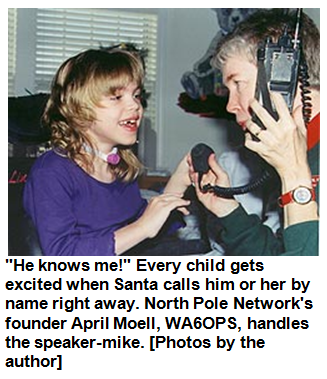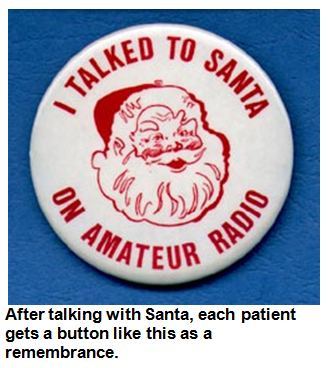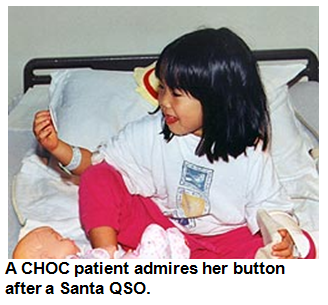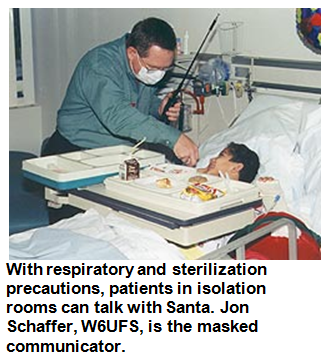Bringing Santa to Kids via Ham Radio
12 Ways to Make It
Better
By Joe Moell KØOV
Originally publlished on the ARRL Web site in 2001
North Pole Network is a quarter-century holiday tradition in Orange County,
California. What better way to introduce hospitalized children and their
families to the magic of Amateur Radio -- and to spread holiday cheer -- than to
arrange to have Santa visit via Amateur Radio?
 "When can your hams come to Childrens Hospital this year?" My wife April,
WA6OPS, hears that question every November. After 25 straight years of ham
radio QSOs between the patients and Santa, the Recreational Therapists don't
wait for us to call them; they call us first, to make sure that we can fill the
optimum time in their busy holiday schedule.
"When can your hams come to Childrens Hospital this year?" My wife April,
WA6OPS, hears that question every November. After 25 straight years of ham
radio QSOs between the patients and Santa, the Recreational Therapists don't
wait for us to call them; they call us first, to make sure that we can fill the
optimum time in their busy holiday schedule.
Kids at Childrens Hospital of Orange County get visits from clowns, carolers,
firemen, baseball players and rock stars. But nobody is more welcome and
anticipated than the ten Amateur Radio operators who arrive on the weekend just
before Christmas to establish a special ham radio link, making it possible for
patients to talk directly to the "real" Santa in his office next to the big toy
workshop at the North Pole.
Ten hams? Couldn't it be done with two or three? Yes, it could, and it was
during the early years. But over time we have discovered how to do it better,
making the experience more efficient, realistic and fun for the patients, the
hospital staff, and the hams. As you start planning holiday activities for your
club, here are a dozen suggestions for your best North Pole Network ever.
1. PERSONALIZE EACH QSO. It's easy to put the mike in front of a little
girl and instruct her to tell Santa her name and where she lives. But imagine
how much better the QSO will be if Santa calls her by name right from the
start. He's Santa Claus, so he should know! Before each year's North Pole
Network session begins, the hospital therapists provide our North Pole station
with the list of names for every room and bed, along with plenty of other
tidbits about the kids that make good conversation starters for Santa. A
typical QSO begins something like this:
WA6OPS: "North Pole Station, this is WA6OPS at Childrens Hospital. Santa, we're
in room 205 by bed 2. Do you know the little boy here?"
Santa: "Ho, ho, ho! Merry Christmas to Childrens Hospital and a special hello
to you, Kyle. How is Rex, your little Chihuahua?"
2. ENLIST THE ELVES. Because the Recreation Therapists at CHOC send
information about each child to Santa in advance, the old boy is never at a
loss for words and he has instant credibility. Therapists also let Santa know
of any sensitive matters. For instance, we don't want him to mention Dad when a
Dad doesn't exist. The CHOC staff loves to do this elf work and sometimes they
even sneak in a little "behavior modification." When Santa greeted one
youngster by name and asked why he was still sucking his thumb, the thumb shot
out his mouth and stayed out for the remainder of the visit.
Just in case that's not enough, we include a "spy elf" in our room-to-room
entourage. She surreptitiously checks the patient rooms in advance and reports
to her North Pole associate on a separate ham band, something like this: "We'll
be in Room 102 next. There's a giant Pooh bear on the chair and the girl is in
her pink pajamas, watching Sesame Street." The associate passes sticky-notes to
Santa, who can work this information into the conversation as he sees fit.
 3. SANTA TALKS TO EVERYONE. Be sure to accommodate the predominant
nationalities and religions in your town. For the large Spanish-speaking
population of southern California, Santa must be bilingual. At least one of our
in-room communicators speaks fluent Spanish, too.
3. SANTA TALKS TO EVERYONE. Be sure to accommodate the predominant
nationalities and religions in your town. For the large Spanish-speaking
population of southern California, Santa must be bilingual. At least one of our
in-room communicators speaks fluent Spanish, too.
When appropriate, Santa gives a hearty Hanukkah greeting. If a youngster is too
sick to speak, St. Nick always has a few words of encouragement for the child
and his family. Sometimes, Santa talks directly with the family.
4. MAKE IT REALISTIC. We work to make Santa's radio voice as clear as
possible, so patients and family can understand every word. Even so, there's no
doubt that it comes from the North Pole. We use a professional audio mixer to
inject the sounds of cold wind and reindeer hooves into Santa's transmissions.
It's perfect for a few seconds just before Santa's voice appears at the
beginning of each QSO. When the talk turns to toys, kids hear the sounds of
elves in the background, busily turning out another year's worth of presents.
Direct feed via the mixer keeps the sounds from drowning out the patients'
voices when Santa is in the receive mode.
5. LEAVE A MEMENTO. We know of clubs that distribute candy canes after
each Santa QSO. They risk protests from the nursing staff. Sweets often violate
dietary restrictions and can be an infection hazard for patients in isolation.
Small toys or stuffed animals are better. For infants and toddlers, they must
be completely kid proof, with no parts that can be pulled off and ingested.
For the past 15 years, we have handed out 2-inch round buttons that say, "I
talked to Santa on Amateur Radio." Everyone loves them, including parents and
nurses. They frequently ask if they can have one, too. (Sure, if they talk to
Santa!).
These buttons are a great form of publicity. The patient's entire family is
reminded that Amateur Radio is the service that brought St. Nick to them. In
early years, we heard ourselves referred to as "the CB group that talks to
Santa Claus," despite our educational efforts. Since we started giving out the
buttons, the confusion has ended.
6. ADD HELPERS FOR EFFICIENCY. To maximize Santa's QSO-per-hour rate
when the hospital is full, we have two or more in-room ham communicators. While
one is in QSO with a youngster and Santa, another is entering the next room,
greeting the patient and family, and explaining what is about to happen. As
soon as one QSO ends, the next can start immediately. Another helper presents
the Santa button to the youngster as the communicator departs.
 7. DON'T BROADCAST IT. If there are "repeater turkeys" in town, be
discreet and don't announce the event on the air ahead of time. After
encountering both "helpful" and malicious breakers during our first North Pole
Network on a repeater, we moved everything to short-range simplex. The 222 and
440 MHz bands have much less traffic than 2 meters, and as a bonus, these bands
are more suited to hospitals--UHF propagation through the halls and floors is
better. Computerized hospital equipment can radiate "birdies" that cause loss
of receiver sensitivity at 144 MHz, but this is seldom a problem on higher
bands.
7. DON'T BROADCAST IT. If there are "repeater turkeys" in town, be
discreet and don't announce the event on the air ahead of time. After
encountering both "helpful" and malicious breakers during our first North Pole
Network on a repeater, we moved everything to short-range simplex. The 222 and
440 MHz bands have much less traffic than 2 meters, and as a bonus, these bands
are more suited to hospitals--UHF propagation through the halls and floors is
better. Computerized hospital equipment can radiate "birdies" that cause loss
of receiver sensitivity at 144 MHz, but this is seldom a problem on higher
bands.
8. PREPARE FOR TECHNICAL ISSUES. Hospitals are concerned about RF
interference to medical equipment. We assure them that our ham H-Ts are not the
same as cell phones--usually banned in hospitals. Experience has shown that the
potential for interference is very low, but one must always be watchful.
If staff does not want you to transmit from a room with respiratory equipment
or a specialized monitor, comply with the request without argument. Transmit at
the lowest power possible. Use a speaker-mike on the H-T and hold the radio
high, away from the patient. Sterilize the mike with alcohol wipes as directed
by nurses when you visit patients in isolation rooms.
9. INCLUDE ALL AGES. Christmas time is an emotional roller coaster for
any hospital patient. The joys of the season can be offset by the miseries of
infirmity and loneliness. You might not think that a talk with Santa on ham
radio would mean a lot to a teenager, a middle-ager, or a senior citizen. But
for many, it's a real uplift.
Patients are cheered by the friendliness and heartened by the fact that a group
of strangers thought enough of them to put on a special program. All the
wonderful memories of past Christmases are rekindled. As one elderly stroke
patient exclaimed into the mike, "Santy, it's good to talk to you again. You
and I go 'way back!" So consider taking North Pole Network to rehabilitation
and convalescent hospitals, as we have done.
10. PLAN AHEAD. Make arrangements with each hospital well in advance,
especially if your group hasn't ever done North Pole Network at that facility.
Every hospital has its own way of organizing activities, so it may take some
persistence to find the right person to coordinate your event.
 At large pediatric hospitals, start with Recreation Therapy or Child
Development departments. At small town hospitals, you may have best results
with the Community Relations person. Keep in mind that many facilities have
only a few children at any particular time.
At large pediatric hospitals, start with Recreation Therapy or Child
Development departments. At small town hospitals, you may have best results
with the Community Relations person. Keep in mind that many facilities have
only a few children at any particular time.
Convalescent or skilled nursing facilities have an Activities Director or
Recreation Leader. These people are always looking for activities for their
patients. If staff members aren't familiar with Amateur Radio, arrange a
meeting beforehand to acquaint them with what you want to do. Show them this
article and tell them about your previous North Pole Network experiences, if
any. Be prepared to demonstrate the equipment that you plan to bring into the
hospital.
11. PROTECT THE MYSTIQUE. Whenever you talk about North Pole Network to
patients, staff, parents or media, remember that Amateur Radio is a global
hobby. Never show doubt that they are QSOing the one and only St. Nicholas,
thousands of miles away at the top of the world. Dealing tactfully with
Scrooges isn't easy, but it's part of the task.
For our 20th Christmas at CHOC, the hospital invited a local TV station news crew to cover the
event. They taped staff interviews and several excellent QSOs, including one
with a girl who spoke for the first time after coming out of a coma. Then the
reporter suddenly asked to interview Santa on camera and demanded that we take
her to him. We refused, saying that the kids were the story, not Santa, and
there was no reason to expose our communications secrets.
It quickly became a stalemate. The reporter briskly told her cameraman to pack
up and they left. We assumed that was the end of the story, but her editor must
have been a true believer. On Christmas morning, we were delighted to see an
excellent three-minute piece on the station's newscast, with staff interviews
and QSOs in English and Spanish, including the child who spoke for the first
time.
12. DON'T MISS THE MIRACLES. Every year, we have had at least one
extra-special encounter that astonished families, staff and the hams. Children
have spoken in a Santa QSO for the first time following brain trauma, fevers
have broken shortly after North Pole Network visits, a head injury patient
started to eat after being encouraged to do so by Santa, and so forth. We don't
know exactly how much the personal contact with Father Christmas has aided in
patients' recoveries, but we are always grateful that our hobby can add a
little joy and holiday spirit to patients and their families.
May this holiday season bring you the most joyous North Pole Network ever.
Joe Moell, KØOV, performs technical magic that brings Santa's voice from the
North Pole to Orange County hospitals every year. April Moell, WA6OPS, leader
of the North Pole Network team, is founder and Coordinator of the Hospital
Disaster Support Communications System. This innovative ARES group provides
radio support to 36 Orange County hospitals.
Text and images ©2001 by Joseph D. Moell. Republication without permission is prohibited.
Back to the North Pole Network main page
Go to the Hospital Disaster Support (HDSCS) home page
Go to the Homing In home page
 This page updated 1 January 2012
This page updated 1 January 2012
 "When can your hams come to Childrens Hospital this year?" My wife April,
WA6OPS, hears that question every November. After 25 straight years of ham
radio QSOs between the patients and Santa, the Recreational Therapists don't
wait for us to call them; they call us first, to make sure that we can fill the
optimum time in their busy holiday schedule.
"When can your hams come to Childrens Hospital this year?" My wife April,
WA6OPS, hears that question every November. After 25 straight years of ham
radio QSOs between the patients and Santa, the Recreational Therapists don't
wait for us to call them; they call us first, to make sure that we can fill the
optimum time in their busy holiday schedule.  3. SANTA TALKS TO EVERYONE. Be sure to accommodate the predominant
nationalities and religions in your town. For the large Spanish-speaking
population of southern California, Santa must be bilingual. At least one of our
in-room communicators speaks fluent Spanish, too.
3. SANTA TALKS TO EVERYONE. Be sure to accommodate the predominant
nationalities and religions in your town. For the large Spanish-speaking
population of southern California, Santa must be bilingual. At least one of our
in-room communicators speaks fluent Spanish, too.  7. DON'T BROADCAST IT. If there are "repeater turkeys" in town, be
discreet and don't announce the event on the air ahead of time. After
encountering both "helpful" and malicious breakers during our first North Pole
Network on a repeater, we moved everything to short-range simplex. The 222 and
440 MHz bands have much less traffic than 2 meters, and as a bonus, these bands
are more suited to hospitals--UHF propagation through the halls and floors is
better. Computerized hospital equipment can radiate "birdies" that cause loss
of receiver sensitivity at 144 MHz, but this is seldom a problem on higher
bands.
7. DON'T BROADCAST IT. If there are "repeater turkeys" in town, be
discreet and don't announce the event on the air ahead of time. After
encountering both "helpful" and malicious breakers during our first North Pole
Network on a repeater, we moved everything to short-range simplex. The 222 and
440 MHz bands have much less traffic than 2 meters, and as a bonus, these bands
are more suited to hospitals--UHF propagation through the halls and floors is
better. Computerized hospital equipment can radiate "birdies" that cause loss
of receiver sensitivity at 144 MHz, but this is seldom a problem on higher
bands.  At large pediatric hospitals, start with Recreation Therapy or Child
Development departments. At small town hospitals, you may have best results
with the Community Relations person. Keep in mind that many facilities have
only a few children at any particular time.
At large pediatric hospitals, start with Recreation Therapy or Child
Development departments. At small town hospitals, you may have best results
with the Community Relations person. Keep in mind that many facilities have
only a few children at any particular time.  This page updated 1 January 2012
This page updated 1 January 2012